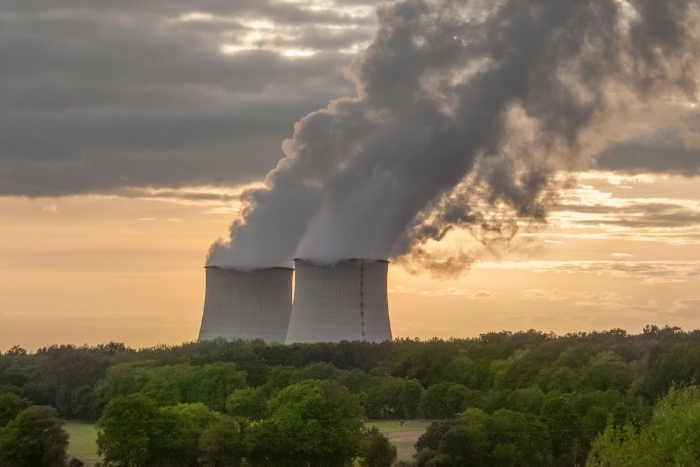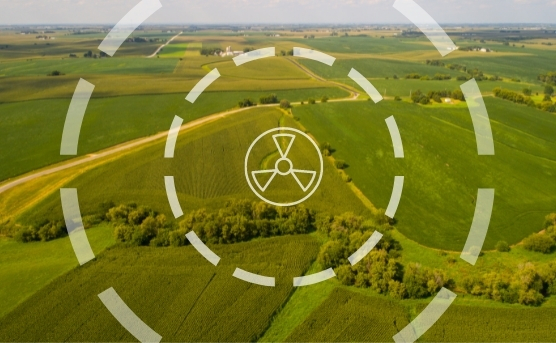Nuclear Power Plants
Disasters and Emergencies
Nuclear Power Plants
Since 1980, each utility that owns a commercial nuclear power plant in the United States has been required to have both an onsite and offsite emergency response plan as a condition of obtaining and maintaining a license to operate that plant. Onsite emergency response plans are approved by the Nuclear Regulatory Commission (NRC). Offsite plans (which are closely coordinated with the utility’s onsite emergency response plan) are evaluated by the Federal Emergency Management Agency (FEMA) and provided to the NRC, who must consider the FEMA findings when issuing or maintaining a license.
Although construction and operation of nuclear power plants are closely monitored and regulated by the NRC, an accident, though unlikely, is possible. The potential danger from an accident at a nuclear power plant is exposure to radiation. This exposure could come from the release of radioactive material from the plant into the environment, usually characterized by a plume (cloud-like) formation. The area the radioactive release may affect is determined by the amount released from the plant, wind direction and speed and weather conditions (i.e., rain, snow, etc.) which would quickly drive the radioactive material to the ground, hence causing increased deposition of radionuclides.
There are two nuclear power plants that operate close to Iowa’s borders; the Quad Cities Generating Station near Cordova, Illinois, and the Cooper Nuclear Station near Brownsville, Nebraska.
Learn more about HSEMD’s Radiological Emergency Preparedness (REP) program.

Know how to prepare for and respond to a nuclear power plant emergency.

Know Your Emergency Planning Zone.
PREPARING FOR A NUCLEAR POWER PLANT EMERGENCY
EMERGENCY CLASSIFICATION LEVELS
- Notification of Unusual Event is the lowest classification, and means that a minor plant event, either an operational event or security threat. Has occurred, but no radiation release is expected. No action by the public is necessary.
- Alert is declared when an actual or potential reduction in the plant’s safety level or a security event that could threaten site personnel or damage plant equipment. No radiation release is expected.
- Site Area Emergency is declared when major safety equipment either has failed or is deemed likely to fail. There is the potential for a minor radiation release that would not exceed Environmental Protection Agency Protective Action Guidelines (PAGs) beyond the site boundary. No action by the public is necessary.
- General Emergency is the most serious of the four classifications. If such an event occurs, radiation could be released that would travel beyond the site boundary. State and local authorities will take action to protect the residents living near the plant.
PREPARING FOR AN EMERGENCY
Emergency Response Plans
Federal, State and local officials work together to develop site-specific emergency response plans for nuclear power plant accidents. These plans are tested through exercises that include protective actions for the general public and special populations.
The plans also delineate evacuation routes, reception centers for radiological monitoring and location of congregate care centers for temporary lodging.
Emergency Planning Zone
State and local governments, with support from the Federal government and utilities, develop plans that include a “plume emergency planning zone” with a radius of 10 miles from the plant, and an “ingestion planning zone” within a radius of 50 miles from the plant.
Residents within the 10-mile emergency planning zone are regularly disseminated emergency information materials (via brochures, the phone book, calendars, utility bills, etc.). These materials contain educational information on radiation, instructions for evacuation and sheltering, special arrangements for special needs populations, contacts for additional information, etc. Residents should be familiar with these emergency information materials.
Emergency Alerts and Notifications
Radiological emergency plans call for a prompt Alert and Notification system. If needed, this prompt Alert and Notification System will be activated quickly to inform the public of any potential threat from natural or man-made events. This system uses either sirens, tone alert radios, route alerting (the “Paul Revere” method), or a combination to notify the public to tune their radios or television to an Emergency Alert System (EAS) station.
The EAS stations will provide information and emergency instructions for the public to follow. If you are alerted, tune to your local EAS station which includes radio stations, television stations, NOAA weather radio, and the cable TV system.
Special Needs Persons
Plans are in place to assist and care for persons with disabilities and access/functional needs. If you or someone you know lives within 10 miles of a nuclear facility, and would need help in an emergency, please notify and register with your local emergency management agency. Adequate assistance will be provided during an emergency.
RADIATION FAQS
Q: What is radiation?
A: Radiation is energy given off by matter in the form of rays or high-speed particles. All matter is composed of atoms. Atoms are made up of various parts; the nucleus contains minute particles called protons and neutrons, and the atom’s outer shell contains other particles called electrons. The nucleus carries a positive electrical charge, while the electrons carry a negative electrical charge. These forces within the atom work toward a strong, stable balance by getting rid of excess atomic energy (radioactivity). In that process, unstable nuclei may emit a quantity of energy, and this spontaneous emission is what we call radiation.
Q: How could I be exposed to radiation?
A: There are many familiar forms of radiation. For example, we use light, heat, and microwaves every day. Doctors use x-rays to see inside our bodies. Radio and television waves bring us our favorite shows. All of these are forms of radiation. Radiation is also naturally present in our environment, as it has been since before the birth of this planet. The sun and stars send a constant stream of cosmic radiation to Earth, much like a steady drizzle of rain. Also, the Earth itself is a source of terrestrial radiation. Radioactive materials (including uranium, thorium, and radium) exist naturally in soil and rock. Essentially all air contains radon, water contains small amounts of dissolved uranium and thorium, and all organic matter (both plant and animal) contains radioactive carbon and potassium. In addition, all people have internal radiation, mainly from radioactive potassium-40 and carbon-14 inside their bodies from birth and, therefore, are sources of exposure to others.
Q: How are radioactive materials used?
A: In medicine, radioactive materials are used for diagnostic and therapeutic purposes. Similarly, in biological and biomedical research, they are used to test new drugs and to study cellular functions and bone formation in mammals. In addition, radioactive materials are used in various industrial applications to protect food and blood supplies, increase the safety of roads and buildings, locate new energy sources, light emergency exits, warn of fires, and more. All users must be licensed by the NRC or by “Agreement States” authorized by the NRC.
Q: If radiation is dangerous, why do we use radioactive material?
A: One could think of radioactive materials as a knife. Used and stored properly, a knife can help us prepare and eat food; misused, it can cause injury and possibly death. Similarly, when handled correctly, radioactive materials have many beneficial medical, industrial, and academic uses.
Information from the U.S. Nuclear Regulatory Commission website.
NUCLEAR POWER PLANTS IMPACTING IOWA
Quad Cities Nuclear Station – Cordova, Ill.
Cooper Nuclear Station – Brownsville, Neb.
RADIOLOGICAL EMERGENCY INFORMATION FOR FARMERS, FOOD PROCESSORS, AND DISTRIBUTORS
The following brochure provides emergency information for the agricultural community within approximately a 50-mile radius of a commercial nuclear power station. It contains information about how you will be notified and what procedures you should follow in the event of a radiological emergency at the power station.